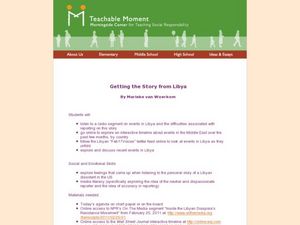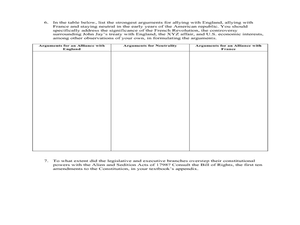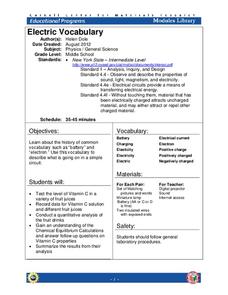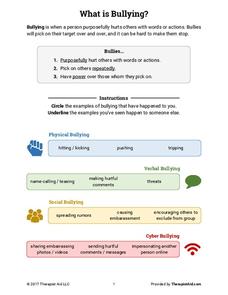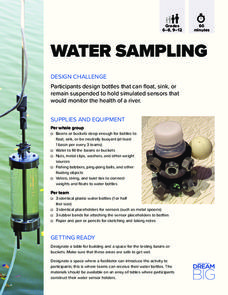Curated OER
Electricity
In this electricity worksheet, high schoolers answer 17 questions about charges on atoms, their number of protons and electrons, the attraction of atoms or objects when charged, the electricity between two objects, grounding and insulating.
Curated OER
Acids and Bases
In this acids and bases worksheet, students answer 18 questions about acids, bases, titrations, pH of solutions and the ions that make solutions acidic or basic.
Curated OER
Acids, Bases, Acid-Base Reactions
For this chemistry worksheet, students read and study the chapter to answer 110 problem solving and short answer questions related to acids and bases.
Curated OER
Getting the Story from Libya
Students examine the state of Libya in the face of civil unrest. In this global issues instructional activity, students listen to audio clips, watch video clips, and read media publications to gain an understanding of the uprising in the...
Curated OER
Cartoons for the Classroom: Tooning into the Candidates: Barack Obama
In this current events learning exercise, students analyze a political cartoon about Barak Obama and respond to 3 talking point questions.
Curated OER
Floating Fishes: Boat Sinking Lab
Cut milk cartons in half to make boats and let investigators attempt to sink them. They add dividing walls and observe what happens if marbles are put into only one of the newly formed compartments. Vocabulary is provided: buoyant force,...
Curated OER
Atom Basics Test
Simple in format and standard in content, this resource is an assessment of your beginning chemists' grasp of the atom. Using a periodic table of elements, they fill in a chart of missing chemical formulas, atomic masses, and numbers of...
Curated OER
The American People, “Creating a Nation”
In this early American history worksheet, students read noted pages in their textbooks and then respond to 7 short answer questions regarding the U.S. Constitution and its formation.
Curated OER
Buoyancy
In this buoyancy worksheet, students review Archimedes principle and the difference between positive, negative, and neutral buoyancy. This worksheet has 1 fill in the blank and 7 short answer questions.
DiscoverE
Action Figure Diver
Will your next buoyancy lab rise to the occasion? Make a splash with action figure divers! Teams of young physicists explore the relationship between mass and buoyancy by adding weights or balloons to achieve a diver that neither sinks...
Cornell University
Electric Vocabulary
Practice electric vocabulary using multiple methods. Learners begin by watching a video that explains vocabulary related to electric currents. They match vocabulary cards to practice and then create an electric circuit. Using the...
Science Geek
Properties of Acids and Bases
It's all about that base! Teach the properties of acids and bases using the sixth slide show presentation in a series of seven. The lesson discusses acid and base properties and reactions. Pupils also see the effect on indicators when...
Therapist Aid
What is Bullying?
What is the definition of bullying, and how can you deal with it? Elementary and middle schoolers discuss verbal, physical, social, and cyberbullying before talking about strategies to avoid and stop bullying in their school.
Humanities Texas
Primary Source Worksheet: George Washington, Farewell Address
Invite your young historians to consider how the first president of the United States envisioned the future of the new nation with this primary source analysis worksheet on George Washington's Farewell Address.
Personal Genetics Education Project
Reproductive Genetic Testing: Technology, Access, and Decision Making
Explore the complexities of reproductive genetic testing respectfully in the learning space. Scientists read articles, view a slideshow, and complete a do-now about genetic technologies. A fishbowl activity allows scholars to discuss the...
National Institute of Open Schooling
p-Block Elements and Their Compounds – II
Ozone, made of three bonded oxygen atoms, is found 15-30 km above Earth, has a strong smell, is blue, and blocks sunlight from hitting the surface of Earth. The 22nd lesson in a series of 36 specifically focuses on the important elements...
DiscoverE
Water Sampling
What is the best way to test water quality? Using plastic bottles, scholars create monitoring sensors to test water quality. Creating three different sensors allows individuals to measure water quality at different water levels.
Pingry School
Solubility Product of an Ionic Compound
How do scientists determine when a solution is fully saturated? Scholars address the topic as they observe patterns of precipitation in various concentrations of ions. Using a well plate, pipette, and common chemicals, they collect data...
National Institute of Open Schooling
Radioactive Pollution
Radioactive pollutants can enter the body through ingestion, inhalation, absorption, or injection. The last lesson in a series of 36 introduces pupils to radioactive pollution. They study its sources, both natural and man-made, its...
US Institute of Peace
Responding to Conflict: Mediation
What happens when two parties can't come to agreement? Scholars explore the role of a mediator through part 10 of a 15-part series of peacebuilding lessons. Through individual work and role play, pupils brainstorm solutions until they...
Constitutional Rights Foundation
The War of 1812: America’s First Declared War
Free Trade and Sailor's Rights! Pupils dive into America's first declared war, the War of 1812. They analyze the presidencies of Jefferson and Madison through diary entries and historical reasoning. To conclude the lesson, they use their...
Constitutional Rights Foundation
The Cold War: How Did It Start? How Did It End?
What is the difference between a Cold War and a Hot War? Scholars research the beginning of the Cold War. They analyze diary entries as well as excerpts from various events during the 45-year standoff. To finish, they prepare final...
Curated OER
Emotion
In this psychology learning exercise, students complete 5 short answer questions on neural pathways of emotion. They explain what aspect of emotion is similar across all cultures.
Creative Chemistry
A Simple Thermoetric Titration
In this thermometric titration activity, learners investigate the temperature changes when an acid neutralizes an alkali. High schoolers graph their results from the titration and draw the two best-fit lines on their graph. Where the...



